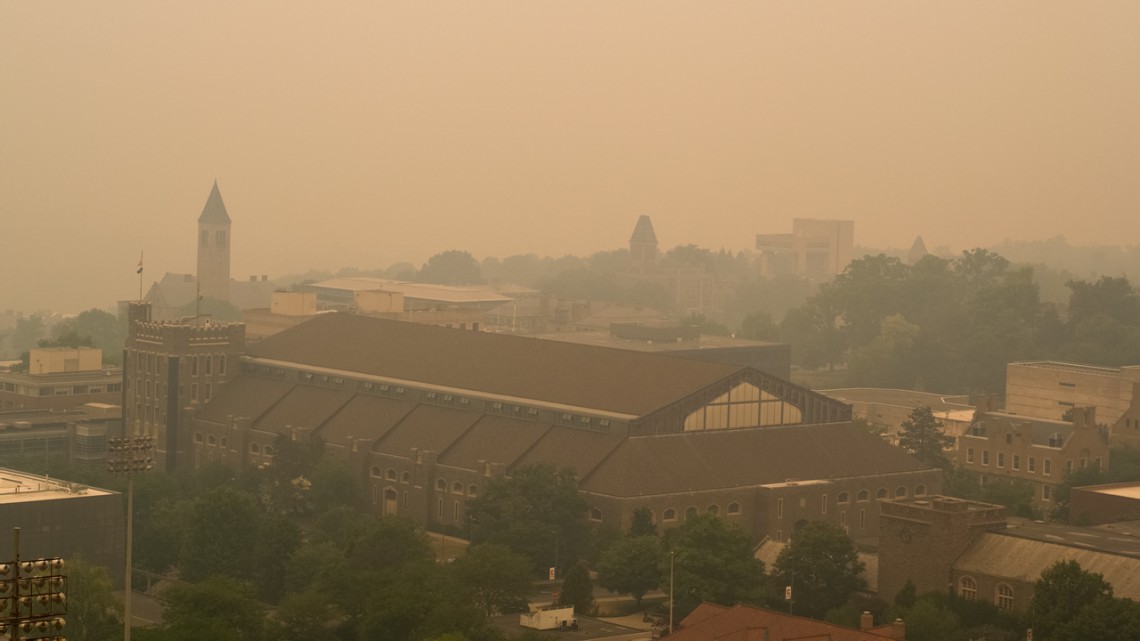
Smoke from wildfires burning in Canada shroud the Sage Hall tower, foreground, and McGraw Tower on June 7. A partnership between the Department of Public and Ecosystem Health in the College of Veterinary Medicine and Cornell Cooperative Extension has installed air-quality sensors in 28 New York counties that had none, helping agencies collect real-time data and provide more timely health alerts to the public.
Cornell expands wildfire smoke sensor network for New York
By Blaine Friedlander, Cornell Chronicle
When wildfires draped heavy smoke over much of the state this summer, nearly half of all New York counties lacked real-time information to determine air quality. Now, a Cornell researcher is leading an effort to install air-quality sensors in 28 upstate counties where there were none.
As of late October, the expansion effort – a partnership between the Department of Public and Ecosystem Health in the College of Veterinary Medicine (CVM) and Cornell Cooperative Extension (CCE) – is nearly complete.
“When the wildfire smoke hit New York, I received questions from partners around the state,” said Alistair Hayden, assistant professor of practice in the Department of Public and Ecosystem Health (CVM). His department tackles emerging environmental threats that involve the interdependent health of people, animals and ecosystems.
“In talking to officials from around the state, it quickly bubbled up that many upstate communities had no data about their air quality,” Hayden said. “Smoke and population health was a concern, and we found that 28 of New York’s 62 counties did not have a single air-quality sensor able to detect fine particulate matter of at least 2.5 microns (PM2.5), which is the main component of wildfire smoke.”
Installing these sensors in all New York counties will allow state and federal agencies to observe smoke plumes in real time, collect data and issue precise, timely alerts to the public. Accurate data will inform local public health prevention-and-response actions, such as school closings, camp warnings and public service messages.
Wildfire smoke can be deadly, Hayden said, and its impact is not felt equally by all groups. “Current estimates are that over 6,000 deaths that occur each year are due to wildfire smoke,” he said. “People who work outdoors – or are unsheltered or living in drafty housing – are highly exposed. Those with the highest risk of death or major health impacts include children, older adults and those with diabetes and heart disease.”
Hayden said that more people in the U.S. have experienced heavy wildfire smoke than a decade ago, but simple policy changes can save lives by improving the infrastructure for obtaining data, alerting populations and protecting communities.
Until this effort, New York counties lacking air-quality sensors were: Allegany, Cattaraugus, Chemung, Chenango, Clinton, Columbia, Delaware, Franklin, Fulton, Genesee, Herkimer, Jefferson, Livingston, Madison, Montgomery, Orleans, Oswego, Otsego, Saratoga, Schenectady, Schoharie, Schuyler, Seneca, Tioga, Washington, Wayne, Wyoming and Yates.
To obtain the sensors and deliver them statewide, Hayden formed a task group that included Gen Meredith, professor of practice in the Department of Public and Ecosystem Health (CVM); Corinna Noel, assistant professor of practice in Public and Ecosystem Health (CVM); Keith Tidball, assistant director of CCE and a senior extension associate; and Adam Hughes, state extension specialist, CCE.
The Cornell Atkinson Center for Sustainability provided rapid-response funding.
CCE and the New York State Association for County Health Organizations helped install PurpleAir Flex air-quality sensors purchased for the project and link them to the Environmental Protection Agency’s Fire and Smoke Map. Now, officials in the New York State Department of Environmental Conservation and the New York State Department of Health, as well as policymakers, researchers and the public, can access air-quality data in real time for many more communities.
“This project was a chance to leverage Cornell’s Department of Public and Ecosystem Health,” Hughes said. “The benefit is now New York has a more complete statewide network of air-quality sensors.”
Tidball said that the national-level Extension Disaster Education Network, or EDEN, is an important part of the land-grant system and mission, as it helps to communicate critical information during natural disasters.
“Cornell Cooperative Extension is always hungry for ways to engage,” Tidball said. “This was an opportunity to engage in a different area – that is a public health and a natural resources crisis space, and I think that CCE shows once again how they have their fingers on the pulse of community needs.”
“The next time we have wildfires and smoke – and it will happen again – all of us will be very glad that these sensors are in place,” Tidball said. “Now, we’ll get more localized, tangible, complete and readily accessible information.”
Meredith is a senior faculty fellow, while Hayden, Noel and Tidball are faculty fellows at Cornell Atkinson.
Media Contact
Get Cornell news delivered right to your inbox.
Subscribe

